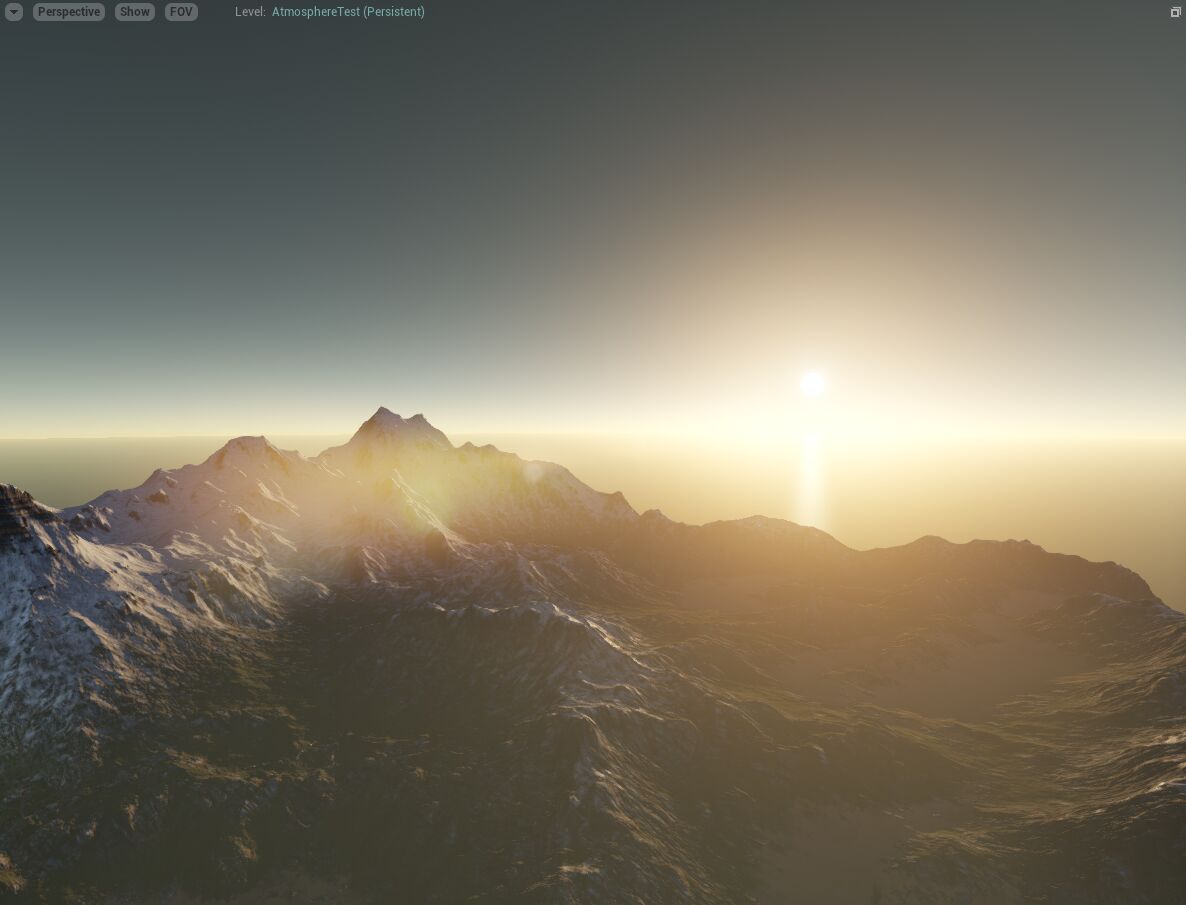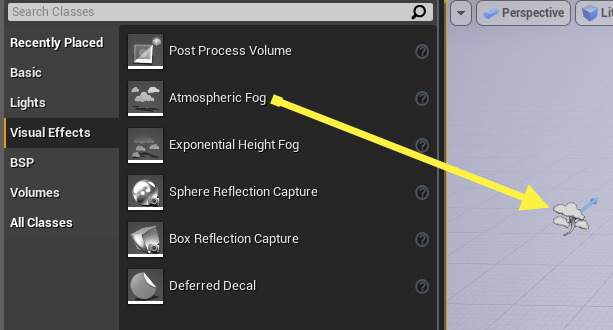Choose your operating system:
Windows
macOS
Linux
Atmospheric Fog gives an approximation of light scattering through a planetary atmosphere. This can give your outdoor levels a much more realistic look. This total effect includes the following:
-
The dominant directional light in your level will receive a sun disc effect in the sky. This will be placed infinitely far away, opposite the light's direction.
-
A sky color that will vary depending on the altitude of the sun (or put another way, how close the dominant directional light's vector gets to being parallel with the ground).
-
Control over scattering and decay settings, allowing for full control of your atmospheric density.

Best of all, the settings for this Actor are easy to use and quick to set up.
Adding Atmospheric Fog to a Level
Adding Atmospheric Fog to your level is as easy as adding its Actor from the Place Actors panel under the Visual Effects section:
This may be done via drag-and-drop:

Atmospheric Fog Properties
The Atmospheric Fog Actor contains the following properties:
|
Property |
Description |
||||||||
|---|---|---|---|---|---|---|---|---|---|
|
Atmosphere |
|||||||||
|
Sun Multiplier |
This is an overall multiplier for the directional light brightness. It brightens both the sky and fog color. |
||||||||
|
Fog Multiplier |
This multiplier only affects the fog color, not the directional light. |
||||||||
|
Density Multiplier |
This control factor only affects the fog density, not the directional light. |
||||||||
|
Density Offset |
This offset value controls fog opacity; its effective range is from -1 to 1. |
||||||||
|
Distance Scale |
Controls a distance factor. The default value of 1 assumes a 1:1 scale of Unreal Units to centimeters. This makes for a very small world. As your world size increases, you will want to increase this value accordingly. Larger values cause changes in the fog attenuation to occur more quickly. |
||||||||
|
Altitude Scale |
Controls the scale along the z axis only. The default value is 1. |
||||||||
|
Ground Color Additive |
Currently, the irradiance color is based on the scene color. This can cause blackening in shadowed areas. To combat this effect, this parameter allows you to add a small boost (i.e. ~0.05) to make the irradiance color more visible in dark areas. |
||||||||
|
Z Offset |
This is an offset for sea level, calculated in km from the location of the Atmospheric Fog Actor. The system does not work for regions below 0 (sea level), so make sure that all terrain remains above this value. This can be used to adjust the height at which scattering and fog color changes take place. |
||||||||
|
Start Distance |
This is the distance from the camera that the fog will start. |
||||||||
|
Default Brightness |
This is the default light brightness, used when there is no sunlight placed in the level. This property is expressed in lumens. |
||||||||
|
Default Light Color |
Used when there is no sunlight placed in the level. |
||||||||
|
Disable Sun Disk |
If checked, disables Sun Disk rendering. |
||||||||
|
Disable Ground Scattering |
If checked, disables color scattering from the ground. |
||||||||
|
Precompute Params |
The properties included in this group require re-computation of pre-computed texture data. They include:
|
||||||||
|
Visible |
Shows or hides the fog effect. |
||||||||
|
Hidden in Game |
If checked, the effect will not be visible in-game. |
||||||||
Example Settings with Images
|
|
|
|---|---|
|
Density Decay Height of 0.5 (8 km) |
Density Decay Height of 0.35 (2.744 km) |
|
|
|
|
Density Decay Height of 1.0 (64 km) and Max Scattering of 4 |
Density Decay Height of 1.0 (64 km) and Max Scattering of 1 |



